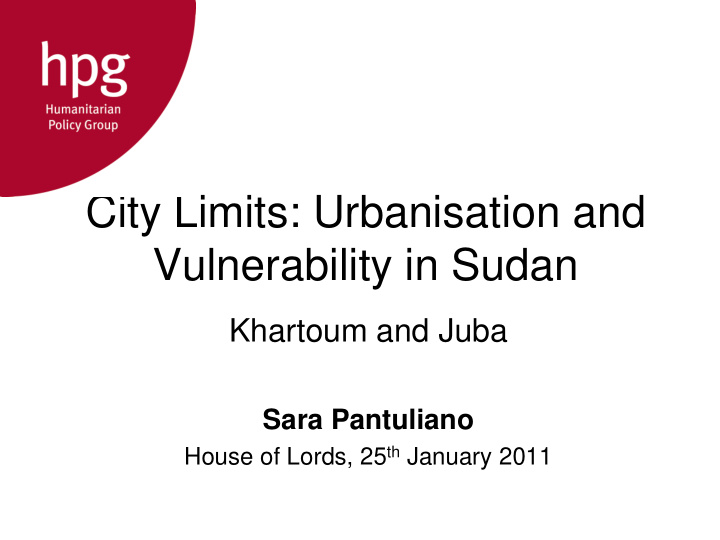



City Limits: Urbanisation and Vulnerability in Sudan Khartoum and Juba Sara Pantuliano House of Lords, 25 th January 2011
Rapid urbanisation • 40% of Sudan’s population reside in towns • Khartoum: 5 million people; Juba: 600,000 - with further increases expected • Until 1970s: pull factors – economic growth • 1970s onwards: push factors – drought and conflict with high levels of displacement • Post-CPA: a combination of both. Many people have been IDPs, refugees and/or economic migrants at various points in their lives • Majority of urban poor seeking better livelihoods opportunities, security and services
Policy overview • Policy formulation has fallen behind the reality of rapid urbanisation • Long history of urban planning, but not always implemented, or overwhelmed by large population movements • Strategies for economic growth and poverty alleviation rural not urban focused • Shifting but generally negative policy towards IDPs
Governance & leadership • Parallel and overlapping systems of administration – North and South • Khartoum: – Popular committees at community level – multiple roles but highly politicised – New generation of urban IDP leaders • Juba – Dual capital: policy of decentralisation clashing with recentralisation of key powers – Contested governance at community level
Urban economy • Economic boom associated with stark and growing inequalities • Close links between economic activity and political power • Dramatic rise in value of real estate and cost of living • Unskilled labour – growing numbers and competition from neighbouring countries • Women increasingly primary breadwinners • Risky/illegal livelihoods strategies • Unemployment of youth linked to gang culture
Land issues • Demand for urban land outstripping availability – proliferation of informal settlements • Evictions, demolitions and relocation – impact of land classification system and master plans – poor people being moved off prime value land • Juba - forceful land grabbing on the rise • Khartoum – impact of GPRs
Access to land • Cumbersome, ambiguous and expensive land allocation process • Unclear eligibility of post ’97 IDPs Khartoum • Accelerated land registration in Khartoum pre- CPA and pre-referendum • Juba – corrupt and contentious land allocation process
Services and urban infrastructure • Service infrastructure failed to keep pace with rising urban population • Municipalities unable to provide effective services • Inadequate access to clean water a major problem • Unaffordability: – concentration of services in city centres – poorest households often faced with highest costs for accessing services
Environmental consequences • Deforestation associated with rapid urbanisation • High levels of pollution: – water & soil contamination related to poor solid waste management – cholera outbreaks – poorest at most risk in peripheral areas • Poorest settlements on land at high risk of flooding (impact on health) • Lack of enforcement of environment protection legislation
Social consequences • Growing insecurity, crime and weak rule of law • Tensions related to wealth and economic status rather than ethnicity • Increasing numbers of street children and associated exploitation • Impact on gender relations – positive and negative • Implications for the post-referendum period?
International assistance • History of strong rural bias • Assumption that urban population is ‘alright’ • Engagement limited to: – humanitarian assistance to IDP camps – annual contingency planning for floods – contingency planning for elections & referendum – some micro-finance initiatives – urban planning in Khartoum and Juba
Challenges….but also opportunities • Opportunities for private sector and small business development • Opportunities to create better educated workforce (both women and men) • Opportunities for cost-effective provision of services to all • Opportunities to harness rural-urban linkages to the benefit of both • Opportunities to foster integration of different ethnic groups
Recommend
More recommend